Agnostic Sunday School, which meets every Sunday in the Lincoln Inn Court Building. The school was founded in February, 1901, and he is the Superintendent and moving spirit of the same. Mr. Sparks is original in his conceptions, a deep student of abstract subjects, and 'as believer in the principles expounded in the Golden Rule. As an orator he has great ability and is gifted with an easy and forcible style of expression, which holds his audiences interested to the end. On the 26th of November, 1896, he was united in marriage to May Elizabeth Buckley, a descendant of members of the House of Lords of England. His children are named Dorothy Grace, Charlotte Ingersoll and Temple Tolstoi. He lives with his family in Covedale, a pleasant suburb of Cincinnati.
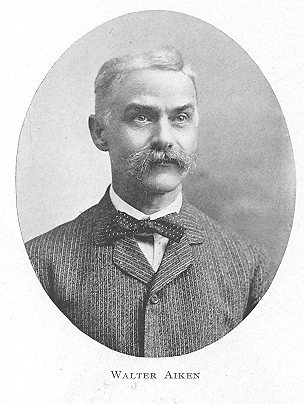
Walter Aiken, Superintendent of Music in the public schools of Cincinnati, Ohio, 'is a musician of more than ordinary ability. He is recognized as an authority on all questions pertaining to music in the public schools of our country. Mr. Aiken is a Cincinnatian, born on the 27th of September, 1856, in the Queen City. His father, Charles Aiken, was a native of New Hampshire, of Scotch-Irish descent, while his mother, Martha Merrill Aiken-, was of English ancestry. His father's people came to this country about the year 1720, and his mother's progenitors about 1.640. Members of both sides of the family took part in the French-Indian War and the struggle for independence from the English yoke. Mr. Aiken's father came to Cincinnati in 1839, and three years later became connected with the music department of .the public schools. He was the first Superintendent of Music of the Cincinnati schools and remained in that position until 1879, when he resigned. He died in 1882. Mr. Walter Aiken received his literary training in the Cincinnati public schools and his Musical education under supervision of his father. He entered upon his professional career at the age of seventeen years, when he accepted the position of Supervisor of Musk in the Middletown schools. He remained in this position for two years, and for three years filled a like position in the schools of Hamilton. In 1879 he came to Cincinnati and became connected with the music department of the schools of the, Queen City in the capacity of Supervisor. For twenty years he served under Superintendent Junkermann. Upon the resignation of Professor Junkermann he was promoted to. the Superintendency On the 1st of August, 1880, Mr. Aiken was married to Miss Lucy B. Avery, a daughter of Dr. C. L.. Avery. Two sons and one daughter are the issue of their union. Mr. Aiken is a member of a number of school associations. For five years he had charge of the herbarium of the Natural History Society, and at the .present writing he is curator of the herbarium of the Lloyds' Library. He has written a number of songs for schools, and has compiled and edited some supplementary work for schools. He lives with his family in College Hill, Ohio.
- 800 -
William Edward Kennedy, Chief Examiner of Stationary Engineers of Ohio, is a man well and favorably known in political and labor circles all over the State. He is a native Cincinnatian, born on the 4th of August, 1862. His parents; Dan. Kennedy, a shoemaker, and Rozane Kennedy, were natives of Ireland, the father having emigrated to the Queen City about 1850. Mr. ,William E. Kennedy received his education in the public schools of Cincinnati, until the age of ten, when he went to work in a machine shop. After many years of hard work, he, in 1886, was offered a position as assistant engineer in the Water Works Department, a. place he filled for a period of four years. In 1890 he was examined for stationary engineer, and received a first-class license. Resigning his position a s assistant engineer, he accepted a place as night engineer with the Cincinnati Ice Manufacturing and Cold Storage Company, but after nine months he took the position of engineer of the Hunt Street Pumping Station. After a period of nine years he again became connected with the Cincinnati Ice Manufacturing and Cold Storage Company, remaining with that firm for twenty months. Returning to the Hunt Street Pumping Station, this time as chief engineer, Mr. Kennedy remained in that position until the 25th of September, 1903, when he was appointed by the Governor to the responsible office of Chief Examiner of Stationary Engineers of Ohio. In political belief Mr. Kennedy is an active working Republican. He is a member and director of the Young Men's Blaine. Club of Cincinnati, and member and Treasurer of the Cincinnati Engineers' Union, No. 1. He lives with his family, consisting of four children, at No. 1129 Gilbert Avenue, Cincinnati. His office is located in i.he Capitol Building, Columbus, Ohio.
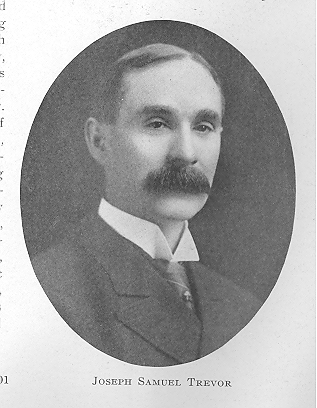
Joseph Samuel Trevor, Councilman-at-large of the city of Cincinnati, and -Secretary and Treasurer of The H. & S. Pogue Company, one of the largest business houses of the Central West, is a native of 'the Emerald Isle, born in 1859. He received his education in the public and private schools of Ireland and emigrated to the United States at the age of eighteen years. Coming to Cincinnati, he secured employment with the above named firm, starting as errand boy, and later working as salesman. His business ability, energy and integrity soon found recognition and appreciation, until to-day Mr. Trevor enjoys the distinction of being one of Cincinnati's foremost business people. Socially, Mr. Trevor is a member of the Masonic fraternity. In political belief he is an unswerving Republican, who has served his party faithfully. In the spring of 1903, after the new code for the municipalities of Ohio took effect, Mr. Trevor was honored by the people of Cincinnati with the election to the City Council, as Councilman-at-large. His record as a public Official is an enviable one. In September, 1885, Mr. Trevor was united in marriage to Miss Kate C. Frazier. Two daughters have blessed their union.
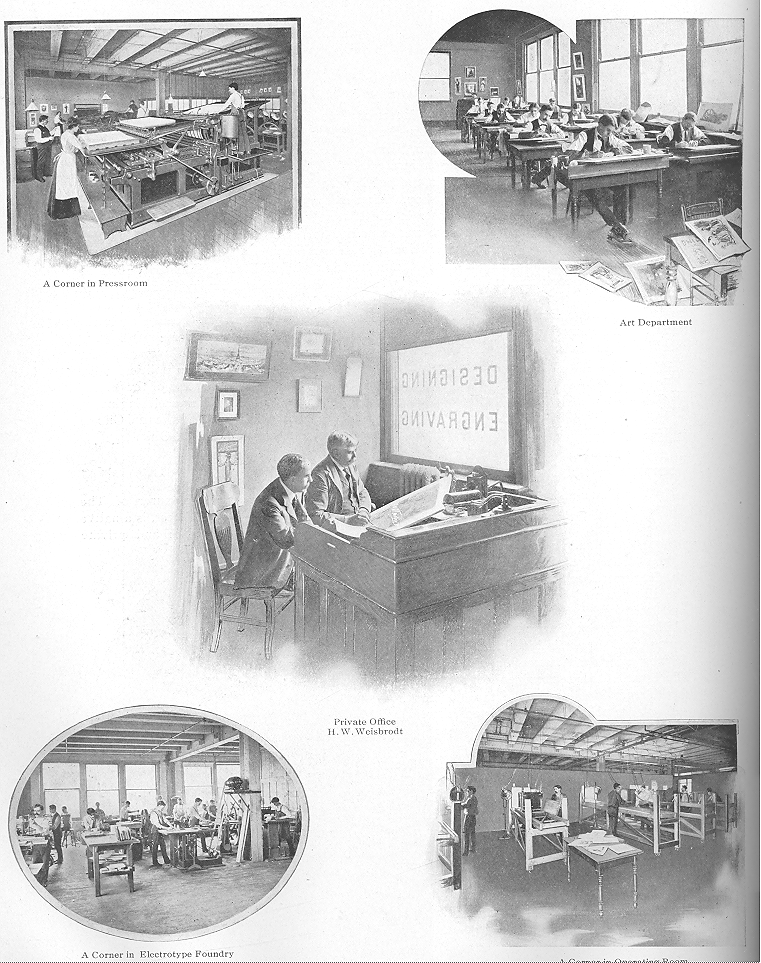
- 801 -

HUGO WILLIAM WEISBRODT, proprietor of the well-known Engraving and Printing firm of H. W. Weisbolt, Cincinnati, Ohio, a business whose reputation extends from the Atlantic to the Pacific and from the Gulf of Mexico to Canada’s frontiers, is a self-made man in the best and fullest sense of th word. He was born on October 26, 1856, at Cincinnati, the son of William and Antonia Weisbrodt, was for many years prompter in the German Stock Company at Cincinnati, Young Weisbrodt received his education in the public schools of his home city. When he was fourteen years of age, he started in the engraving business as apprentice with Joseph A. Williams, at that time the leading wood engraver in Ohio. After an apprenticeship of three years, and after mastering all the details of his profession, young Weisbrodt started in business of his own. His enterprise was a success from the beginning, thanks to the ability and thoroughness of the young proprietor, who always kept himself abreast with the times and never let an opportunity slip by to improve his methods. In order to study the art of making halftones, he, in 1882, crossed the ocean and went to Munich, Bavaria, where he learned the process of halftone engraving. It was left to Mr. Weisbrodt to improve this process in many ways, and it can be truthfully said, that his establishment has no superior on both sides of the Atlantic. The splendid pictures and portraits, which appear in this work, amply show his ability. After returning from Munich to his native city, Mr. Weisbrodt opened a business in the Esplanade Building, on Fifth and Walnut Streets, later removing to the Blymyer Building and to the Oskamp Building. These removals were always necessitated on account of the growth of Weisbrodt's business. Two years ago the business moved in the Commercial-Tribune Building, where a printing establishment was added to the engraving and electrotyping departments. The firm of H. W. Weisbrodt is considered to be one of the best equipped in the United States. "We do it all" is the motto of Mr. Weisbrodt, and in fact, there is hardly any firm in the printing and engraving line in the United States, which can boast of such splendid and modern equipment as Weisbrodt's. An convince everybody of the correctness of the above statement. Mr. Weisbrodt is one of the most progressive and popular business men of the Queen City. Jovial of nature, of affable and pleasant manners, and thorough business instincts, Mr. Weisbrodt possesses all the qualities which are bound to make a man successful in everything he undertakes. He expects nothing of his numerous artists what he is not able to do himself. In social life he is a Mason and a member of the Mystic Shrine. He was married to Miss Alice Miller, daughter of the late William Miller, in 1884, and lives with his wife in a splendid mansion in Avondale, Cincinnati, Ohio.
- 803 -
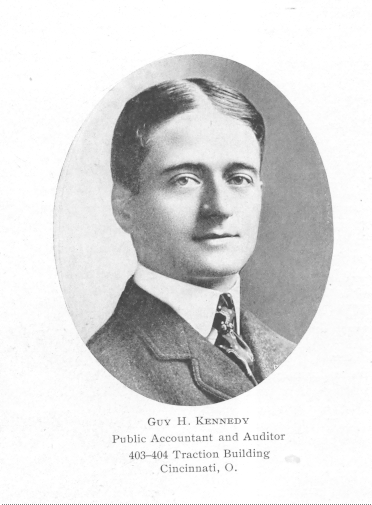
George Klotter, President and Treasurer of the Bellevue Brewing Company, of Cincinnati, Ohio, and a man who stands high in the esteem of his fellow citizens, was born on the 25th of August, 1835, in the city of Cincinnati. His father, George Klotter, a native of Baden, Germany, emigrated to the United States in 1835, settling in the Queen City, where in 1846 he founded Sohn's Brewery. Mr. George Klotter was educated in the public schools of his native city and received a collegiate training at the well-known St. Xavier's College. At the age of fifteen years he became employed by Gustav Herder, a hardware man, working there for five years. The three following years of his life were spent in his father's brewery, and then he became first asisstant of H. A. Rattermann, who had just founded the German Mutual Insurance Company. In that business he met with considerable success, and later he became a partner in Klotter's Sons Brewery, the present Bellevue Brewing Company. On the 1st of January, 1900, he was made President and Treasurer of that flourishing corporation, in which since its incorporation in 1888 he had filled the position of Secretary and Treasurer. Mr. Klotter is recognized among all classes, irrespective of nationality, as a man of splendid natural ability, broad-minded, progressive, and with the welfare of the people at heart. He belongs to a number of charitable and social organizations, and there never has been made a worthy call upon his purse that he has not been ready to immediately grant. His marriage occurred in 1856, when he took for his wife Miss Margaretha Wuest. His wife has been dead for over twenty-five years, but the union has been blessed by three sons and six daughters.
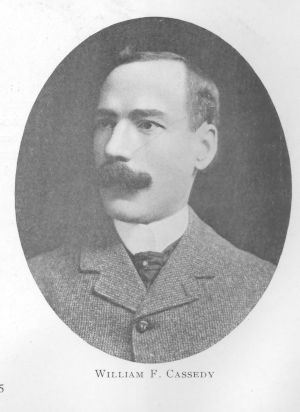
William F. Cassedy, President of The James A. Cassedy Company, book binders, at Cincinnati, Ohio, is a native Ohioan of Scotch-Irish descent. He was born in the Queen City in 1866, where his father, James A. Cassedy, was a prominent book binder, and a pioneer in his business. For thirty-eight years he had been in charge of the book binding department of the Methodist Book Concern. He resigned that position and in 1882 organized a firm of his own, which soon became an important factor in the world of books. Thirteen years later the business was reorganized as a stock company, and Mr. W. F. Cassedy was chosen as its President, a position he still holds with marked success. Mr. Cassedy was educated in the public schools and Hughes High School of Cincinnati, and at the age of eighteen years he entered the business of his father, learning all the details of his art. The Jas. A. Cassedy Company enjoys the distinction of not only being the largest book binding business in the State of Ohio, but of creating the most beautiful and artistic covers in the United States. The products of the firm can be found in any library, and the binding of this work has also been done by the Jas. A. Cassedy Company.
- 805 -
The plant of the firm is equipped with the most modern machinery, and its capacity is almost unlimited. Mr. William F. Cassedy is a business man of more than ordinary ability and .enjoys great popularity in his native city. He is a Scottish Rite Mason and a member of the Cincinnati Business Men's Club. He lives with his family, consisting of his wife, a daughter and a son in Ludlow, Kentucky. His plant is located in the Commercial Tribune Building, Cincinnati, Ohio.
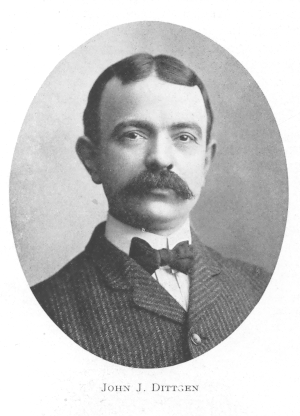
John J. Dittgen, Mayor of Madisonville, Ohio, and proprietor of the printing firm of Dittgen & Co., located at 641-643 Main Street, Cincinnati, Ohio, is one of the best known Democrats in the southwestern part of the State. He is a native of Indiana, of German parentage, born on the loth of May, 1861, his parents, John Dittgen and Clara Dittgen, having emigrated to the United States when quite young. Mr. John J. Dittgen received his education in the public and private schools of Madison, Indiana. After leaving school, he learned the printing trade. Coming to Cincinnati at the age of seventeen years, he followed his vocation for a number of years, until, in 1881, he started in business for himself, which in the course of time has become very successful. The firm makes a specialty of the manufacture of cigar and tobacco pouches and bags, which are made by special machinery, invented, patented and built by Mr. Dittgen. The latter is a business man of marked ability, who enjoys the esteem and confidence of his fellow citizens to a high degree. Socially, he is a member of the Masonic fraternity and of the K. of P. rn political belief, he is a staunch supporter of the principles of the Democratic party, and has served the party of his choice in many capacities. For many years he has been a member and director of the celebrated Duckworth Club of Cincinnati, the Democratic crack organization of the Central States. In 1886 Mr. Dittgen moved to Madisonville, and the year following he was elected to the Village Council. He served with such distinction, that he was ye-elected twice to the same office. In October, 1897, after the death of Mayor J. Anderson Ward, Mr. Dittgen was appointed to fill the unexpired term of that gentleman. Since that time he has continuously filled that office, being elected to that responsible position in the years 1898, 1900, 1902 and 1903. His term of office will expire in January, 1906. Mr. Dittgen enjoys the reputation of being a model chief executive, his administration being clean and business like. He is married, and has two children, a son and a daughter, his wife being formerly of Brooklyn, New York. Mr. Dittgen resides with his family in Madisonville, a pretty suburb of the Queen City.
- 806 -
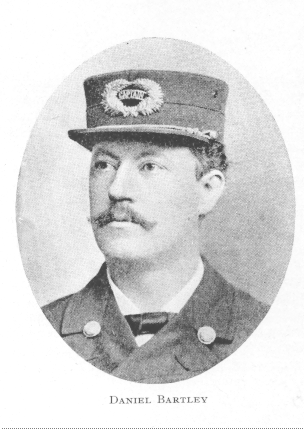
Daniel Bartley, Captain of the police of Chester Park, Cincinnati, Ohio, is a man well known in police circles all over the State. He is a native Ohioan, born on the 11th of January, 1863, at Cincinnati, where his father, Daniel Bartley, Sr., was engaged in the contracting business. Mr. Bartley, Sr., was for eighteen years Marshal and Superintendent of Roads of Clifton, and he planted many of the beautiful trees which adorn the driveways of that pretty suburb. Mr. Daniel Bartley received his education in the common schools. Upon leaving school, he became engaged as teamster in the employ of his father, in which business he remained, until he accepted a position with the Metropolitan Police of Cincinnati, under Colonel M. F. Riley and Colonel Armstrong. After having served in that capacity for a period of six and a half years, he, in 1891, joined the guards of the Cincinnati Workhouse. One year later, he was promoted to the positions of Sergeant and Lieutenant, and in May, 1895, he was elected Deputy Superintendent of that institution, in which position he made a brilliant record. After the new code for the Ohio municipalities took effect, in May, 1903, and the Cincinnati Workhouse ca me under the supervision of the Board of Public Service, Mr. Bartley left his position, after having served twelve years and twenty-six days. He then accepted the position of Captain of the Chester Park police. He was married in 1887, and is the father of four boys and one girl. Socially, he is a member of the Blue Lodge, F. & A. M.
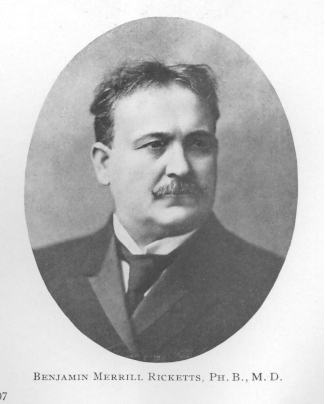
Benjamin Merrill Ricketts, Ph. B., M.D. Of Cincinnati, Ohio, was born in Proctorville, Brown County, Ohio, on the loth of May, 1858. He is the son of Dr. Girard Robinson and Rachel McLaughlin Ricketts. Dr. Ricketts received his early education in the public schools of his home city, and attended the Ohio Wesleyan University at Delaware and the Miami Medical College of Cincinnati, from which institution he graduated in 1881. He practiced his chosen profession at Ironton, Ohio, for two years, and at Columbus, Ohio, for one year. During the years of 1884 and 1885 he was a student in the Medical Department of the Columbus University, and in 1884
- 807 -
was house surgeon of the Skin and Cancer Hospital at New York City. He was Professor of Chemical Surgery in Miami Medical College during 1886 and 1887, and in the "following year organized the Cincinnati Polyclinic, which was devoted exclusively to post-graduate work. He was visiting physician for skin diseases and cancer at the German Deaconess' Hospital, Christ Hospital and the Presbyterian Hospital. In 1895 he resigned all his hospital positions to devote his time exclusively to the perfection of his knowledge of surgery by practical experiments. In 1887 he opened his private hospital on Fourth and Broadway. His studies and experiments have been of great benefit to the medical profession and to the people at large, as he has contributed many important and valuable articles to medical journals and societies. For a long period he was engaged in interesting and original experiments in the surgery of the heart and lungs. The results of his research were in part made known at various times to the medical world through published articles, as mentioned above, as well as addresses to different learned bodies, the whole being edited and published in book form under the title of "The Surgery of the Heart and Lungs." Dr. Ricketts belongs to the following societies : The Ohio State Medical Society, The Cincinnati Academy of Medicine, The American Medical Association and the Cincinnati Society of Natural History. On the 20th of May, 1885, Dr. Ricketts married Miss Jennie L. Clark, of Ironton. On the 16th of December of the same year she died, and in 1891 he married Miss Elizabeth Laws. Two sons are the issue of their union.
Edwin Ricketts, M. D., A representative member of the medical profession in the city of Cincinnati, Ohio, was born on the 18th of May, 1853, the son of Dr. Gerard R. and Jane McLaughlin Ricketts, natives of Virginia and Ohio, respectively, and descendants of Scotch and Irish progenitors. The father's ancestors came to the United States about 1770, and settled in Virginia. Dr. Ricketts' early education was obtained in the common schools of Marshall, Ohio, and he later attended Wesleyan and Annapolis Universities, after which, deciding to follow his father's profession, he took a course of study at the Miami Medical College, at Cincinnati, and at the Medical Department of the Columbia University at New York. Upon receiving his degree he located in the city of Portsmouth, Ohio, in March, 1877, where he practiced until September, 1888. He then went abroad and for one year devoted himself to the study of surgical diseases of women. Returning to his native land, he took up his residence in the Queen City, where he has been engaged in the medical practice ever since. He is a well-known contributor to medical journals on subjects pertaining to surgery. Dr. Ricketts belongs to a number of professional organizations.

B. F. Clark, M. D., One of the best known physicians of Cincinnati, Ohio, and since the last twelve years surgeon of the Cincinnati Fire and Police Departments, is a native Cincinnatian, born on
- 808 -
the 1st of October, 1856. His father, Benjamin Clark, a mechanic, was of Scotch-Welsh ancestry, his forbears having settled in this country about 171o, while his mother, Julia Ann Bevin Clark, was of Pennsylvania German descent. Dr. Clark received his education in the Cincinnati public schools, Hughes High School and the Medical College of Ohio, from which latter institution he graduated with the degree of M.D. After his graduation, Dr. Clark went abroad and took a special course of study at the celebrated Universities of Strassburg and Vienna. Returning to his home country, he settled in Cincinnati, and became engaged in the practice of his profession, in which he obtained a high standing. Dr. Clark is a member of the Cincinnati Academy of Medicine. In political belief he is a staunch Republican, and is a member and Vice President of the Blaine Club. Socially, he belongs to the Masonic fraternity, and is Past Eminent Commander of the Cincinnati Commandery Knights Templar, No. 3. In 1883, he was united in marriage to Miss Allie Fisk. Two daughters have been the issue of their union. For a period of ten years Dr. Clark was Chief Surgeon of the C., H. & D. and the B. &. 0. S. W. Railroads. For the last six years he has been United States Pension Examiner. Dr. Clark is President of the staff of St. Francis Hospital and Special Examiner for the Locomotive Engineers' Association and the National Association of Traveling Freight Agents.

John G. Reed, M.D., One of the foremost physicians of Cincinnati, Ohio, is a native Indianian, born in 1853 in Noble County. He obtained his education in the independent school at Glenvale, Ohio, after which he took a training course at the Normal School at Lebanon, Ohio, to prepare himself for the teacher's profession. After leaving that institution, Dr. Reed taught school for a couple of years. He then entered the Cincinnati College of Medicine and Surgery, graduated from same in 1876, and entered upon the practice of his profession in the Queen City. Three years later, in 1879, he took a post-graduate course at the New York Polyclinic, after 'which, in order to regain his health, he settled in the little country town of Westchester, Butler County, Ohio. where he practiced until 1886. In the latter year he came to Elmwood Place, and in 1898 he also opened an office in Cincinnati. Here he soon became known as one of the most efficient physicians of that city. Dr. Reed is a member of the Cincinnati Academy of Medicine, the Ohio State Medical Association and the Mississippi Valley Medical Association. For a period of five years he occupied the Chair of Anatomy in the Cincinnati College of Medicine and Surgery. His offices are located in the Groton Building, Cincinnati, and at Elmwood Place, Ohio.
- 809 -
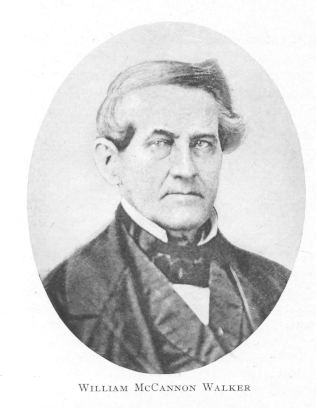
William McCannon Walker, A prominent citizen of early Cincinnati, was born in Newcastle County, Delaware. on the 27th of June, 1789. In 1805 he moved to Philadelphia, where he attended school. When he grew up, the desire to go West became so strong that he took his family and traveled to Cincinnati, in 1825. He lived first on the west side of Broadway below Fourth Street. He was a man of great attainments, and took an active part in the social and business life of early Cincinnati. He invented a method of making gunney sacks which became universal. His name appears on record as one of the most ardent supporters of the movement both for the Whitewater and Miami Canals. He had a factory located on the site of the present Water Works. He died on the 4th of October, 1870, leaving a widow and the following children : Matilda Smith, Caroline Blair, Mary Bryson and Louise Walker.
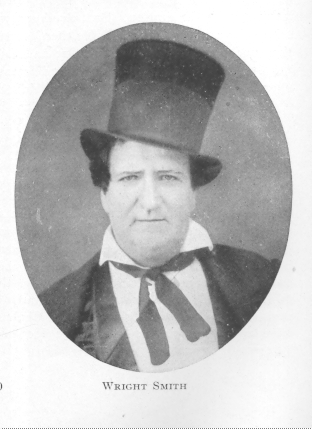
Wright Smith, A pioneer merchant of the Queen City, who enjoyed the esteem and confidence of his fellow citizens when Cincinnati was quite young. He was born in Boston, Massachusetts, on the 4th of November, 1811, and came West and located in Cincinnati in 1819, with his father, Wright Smith. In 1835 he married Hannah Matilda Walker, daughter of William Walker. Their home was on the southeast corner of Race and Sixth Streets.. He entered the mercantile life, opened a store on the west side of Main Street, above Fourth Street, and was very successful. In 1841 he moved to Boone County, Kentucky, and four years later to Covington. He was a life member of the old Cincinnati Volunteer Fire Department.
Mr. Smith died on the 12th of March, 1862, leaving a widow and five children : Mary Walker Ranson, Wright, William Walker, Sallie R. Woods and Oliver Smith.
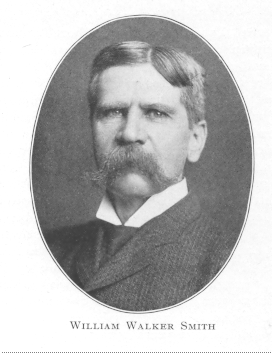
William Walker Smith, Was born in Boone County, Kentucky, on the 17th of January, 1843, where his father, Wright, had recently moved from Cincinnati, Ohio. He first went to school in Covington, in Miss Harbley's private school, and after-
- 810 -
wards studied under John G. Carlisle in Covington High School. At an early age he entered the steamboat business, and became clerk on the Hettie Gilmore. When the war broke out Mr. Smith was making a, trip on the steamboat Hettie Gilmore on the Red and Onchita Rivers. The Confederates captured the boat, compelling him to walk back to Covington, Kentucky, as he had no money. He was on the steamboat Messenger when that boat burned in 1862, near Pittsburg. In 1864 he went into the grocery business with William G. Hill. Their first store was located on Madison Street, Covington, Kentucky. In 1871 they moved to No. 45 Vine Street, Cincinnati, where they carried on a wholesale grocery business. They continued in that location until 1895, when Mr. Smith retired. Mr. Smith had great faith in real estate in the suburbs of Cincinnati, and was a pioneer in building apartment houses outside of the city, proper. He never took part in politics, and belonged to no organizations except the Chamber of Commerce and the Masonic fraternity, being a member of the Golden Rule Lodge of Covington, Kentucky. Mr. Smith married Emily Louise Van Deventer, the daughter of Peter S. Van Deventer, of New Brunswick,
New Jersey. They had two sons, William Walker Smith, Jr., and Edwin Van Deventer Smith.
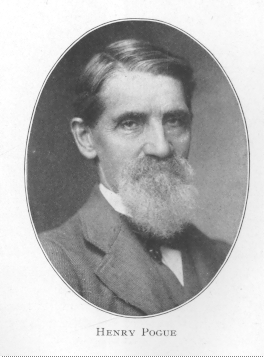
Henry Pogue, Deceased, who during his existence was one of the most prominent merchants of Cincinnnati, and who died on the 15th of January, 1903, of bronchial pneumonia, was born in ay, 1829, in County Cavan, Ireland, and was Le of five brothers who came to Cincinnati id engaged in business. He received his education in the schools of his home county, Ld after serving an apprenticeship in the dry goods business in the town of Cavan, came to e United States in 1851. He located in Cincinnnati and obtained a position in a dry goods ore on Fifth Street. Just prior to the Civil rar, Henry Pogue bought an interest in a nail dry goods store on Fifth Street, and entered the arena of business under the firm name of Pogue & Jones. In 1865, despite the depression incident to the war, the business id so prospered that Mr. Pogue was able financially to buy the large interests of John
- 811 -
Crawford, who afterwards became his father-in-law, and formed the company of the H. & S. Pogue Company, Samuel Pogue becoming a partner. Later, the other brothers, Thomas, William and Joseph, also entered into the partnership. In 1878 the business was removed to the present location, on Fourth Street, between Race and Vine Streets. Later the company acquired the corner of Fourth and Race Streets, and erected what is considered the greatest dry goods emporium west of New York. Henry Pogue was the Secretary and Treasurer of the great company he founded, of which his only surviving brother, Samuel, continues as President. His two sons, Henry and John, have entered the firm, and will help carry on the business which owes so much of its remarkable growth to the enterprise of their father. Although gifted with a business faculty which enabled him to excel competitors, Mr. Pogue was something more than a merchant, and was well qualified by nature, study and travel to fill any position in life ; but his tastes were so simple, his wants so few, that he sought neither social nor political distractions. He belonged to several clubs, but to no secret organizations. His elegant home, with the domestic circle intact, his well selected library, his treasures of art, his choice of friends, and his private deeds of beneficence made up the sum of interest in his life, outside the cares of his business. He was a man of strong will, and this was noted in his last illness, when, through its sheer force, he combated with death until he could take one last look upon his sons, who had been hurriedly summoned from college. Mr. Pogue was an acknowledged Christian, a pioneer member of the Central Presbyterian Church at Mound and Barr Streets, and was for years its treasurer. He was a man of a kind, loving and generous disposition, and extremely charitable. Mr. Pogue married Mary 0. Crawford, second daughter of John Crawford, and he is survived by his widow and six children, viz.: Mrs. William Walker Smith, Jr., Elsie, Natalie and Margaret, and Henry, Jr., and John Crawford.

William John Williams, Secretary of the Western and Southern Life Insurance Company, of Cincinnati, Ohio, is a man conceded to be an authority on all questions pertaining to the business in which he is engaged. He is a native Cincinnatian, horn on the 8th of March, 1858. His parents, William G. Williams and Mary E. Williams, were natives of New York and Ireland, respectively. The parents gave their son the advantages of a thorough literary and business education and sent him, after passing through the public schools of Cincinnati and Woodward High School, to St. Xavier's College. Subsequently he took a course of business instructions in the Nelson Business College at Cincinnati. Mr. Williams started into public life at the age of twenty years, filling the position of a clerk in a local insurance office, where he first received his knowledge of the business. By his own initiative he has forced his way to the front, until to-day he is one of the most important factors in the
- 812 -
insurance business in the State of Ohio. In 1887, upon the organization of the Western and Southern Life Insurance Company of Cincinnati, Ohio, Mr. Williams was elected to the office of Secretary of that corporation, a position which he has filled with marked success. Mr. Williams is a man of pleasing address, with a kindly and courteous manner, thereby making a host of friends. As a business man he combines rare executive ability with sound judgment and aggressiveness. Socially, he is a thirty-second-degree Mason and a Knight Templar. In 1889 Mr. Williams was united in marriage to Emma J. Morris, by which union he is the father of one son, Frank Caldwell Williams. His residence is located at No. 1235 Ida Street, and his place of business corner of Fourth Street and Broadway, Cincinnati, Ohio.
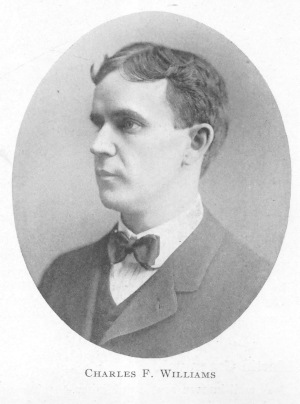
Charles F. Williams, Attorney at law at Cincinnati, Ohio, and special counsel in the office of the Attorney General, is one of the best known and most promising younger attorneys of the Queen City. He was born on the 23d of April, 1873, in Cincinnati, his parents, William G. Williams and Mary E. Williams, being natives of New York State and Ireland, respectively. Mr. Charles F. Williams received his education in the public and High Schools of Cincinnati, graduating from Woodward High School in 1891. Later he took up the study of law and attended the well-known Cincinnati Law School, from which celebrated college he graduated in 1897. Since that time he has been continuously engaged in the practice of his chosen profession, meeting with splendid success. Mr. Williams is recognized to be a conscientious, painstaking lawyer, who enjoys the confidence of his fellow practitioners and the people in general. In political belief he is a staunch Republican, who has served his party in many capacities. He was elected to the Lower House of the Seventy-fifth and Seventy-sixth General Assemblies, where he served with great distinction. Notwithstanding his youth, he was considered to be one of the most valuable and efficient members of the Legislature, and his advice was often sought. Mr. Williams' offices are located in the Traction Building, Cincinnati, Ohio.
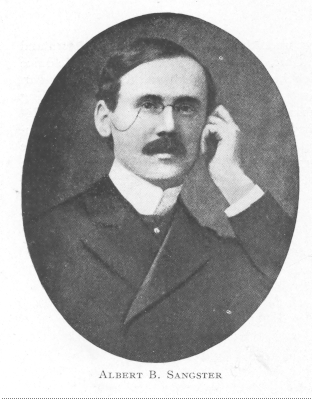
Albert B. Sangster, Of Cleveland, Ohio, a teacher of piano, harmony and history of music, is one of the most promising young musicians in the northeastern part of Ohio. He is a native of the Forest City, and is the son of James W. and Ellen C. Sangster. Mr. Sangster enjoyed the advantages of a thorough education, both literary and musical, displaying in early youth a splendid ability for the art, which he has made a life study. He was instructed by the best musical talent obtainable. After finishing his musical studies, he engaged in teaching piano, with studios in the Bangor Building, corner Erie and Prospect Streets, Cleveland, Ohio. His ability as a teacher has been demonstrated beyond doubt, and that he is a capable musician
- 813 -
is evidenced by the many flattering encomiums given to him by the musical critics of his native city. Mr. Sangster has large classes of pupils belonging to the foremost Cleveland families who have made a remarkable progress under his able instructions. He believes in the broadening of the young students by the history and theory of music, thereby developing in them an inspiriting desire to perfect their natural talents. His work is thorough and painstaking. Mr. Sangster resides at No. 185 Streator Avenue, Cleveland, Ohio.
Hamilton E. Hoge, Prosecuting Attorney of Hardin County, Ohio, is a lawyer of extraordinary ability. He is the son of a prominent banker of Kenton, and received a very careful education. After leaving school, he took up the study of law, and in due time was admitted to the bar before the Supreme Court of the State of Ohio, taking up the practice of. law immediately afterward. Mr. Hoge enjoys the fullest confidence of his fellow practitioners and the people of his home county in general. The latter elected him to the responsible office of Prosecuting Attorney of Hardin County, a position he fills to the utmost satisfaction of his people and with credit to himself. Mr. Hoge, who is still a young man, is a conscientious and painstaking lawyer and a brilliant orator. There is no doubt but that there are more honors in store for him. He lives in Kenton, Ohio.
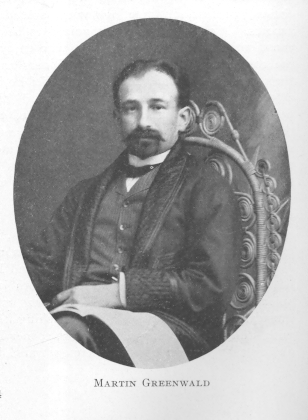
Martin Greenwald, A well-known music publisher, teacher and conductor of prominent singing societies in the Capital City of Ohio, was born on the 29th of December, 1872, in Breslau, Silesia, Germany. He is the offspring of a family of accomplished musicians, and his father, Hermann Greenwald, was a Supervisor of Music in the schools of his native city. Mr. Greenwald emigrated to this country in 1893, after having received a thorough literary education in Breslau and Berlin, in which latter city he attended the Graue Kloster-Gymnasium. His musical studies were directed by the great Moskowski, and by the masters of the famous Royal Conservatory of Music, at Leipsic, Germany. After having taught music in the old
- 814 -
country for a period of two years, Mr. Greenwald came to the United States and settled in Columbus in 1899. Here he almost immediately took a leading part in the musical affairs of that city, and became a teacher and conductor of German singing societies, and since 1904 a publisher of music. Prior to his coming to Columbus, Mr. Greenwald followed his profession in New York City, Binghamton, New York, and Concord, New Hampshire, in all of which cities he is well and favorably known. Mr. Greenwald has composed a number of piano studies and male choruses. He is a publisher of music of established, reputation. His residence and studios are located at No. 967 Dennison Avenue, Columbus, Ohio.
Carlos Emme, Concert pianist, instructor of music, and musical director in the city of Columbus, Ohio, was born on the 17th of December, 1849, in the city of Hamburg, Germany. His father was bookkeeper in the celebrated Hamburger Nachrichten, in later years the organ of the Iron Chancellor, Prince Bismarck. Mr. Emme was carefully educated in the Hamburg schools, and having manifested unusual talent for music, was given into the hands of the best musical masters in his home city. He studied 'piano under Julius Zander, and theory under the famous Emil Krause. At the early age of eleven years Mr. Emme appeared in public, creating a sensation for his remarkable ability on the piano. Deciding to devote his life to the profession of music in the New World, he, in 1867, emigrated to the United States, landed in New York, and in this metropolis of the East commenced his career as a teacher at the age of nineteen. For twenty-eight years Mr. Emme remained in that city, where he not only practiced his profession as a teacher, but also often appeared in his capacity as piano virtuoso. His first appearance in New York was in Steinway Hall. From New York he often made concert tours, playing in the large cities, like Philadelphia, Buffalo, Cincinnati, New Haven, etc., meeting everywhere with pronounced success. After remaining in New York for a period of twenty-eight years, Mr. Emme removed to Cincinnati, where he was connected with musical affairs for six years. Since then he has made Columbus his home, and is looked upon as a teacher and soloist of great merit. He is a composer of numerous pieces for the piano as well as songs. His best known compositions are a "Polonaise Brillante," "Sailors' Song," etc. Mr. Emme resides at No. 26o East Mound Street, Columbus, Ohio.
M. F. Trostler, Proprietor of Trostler's Dancing Academy, Cleveland, Ohio, is a teacher of the art of dancing, of more than local reputation. The practical and scientific method of instruction originated by Mr. Trostler makes every lesson given by him a pleasant recreation instead of a fatiguing exercise. The artistic elegance and luxurious appointments of his establishments are in themselves a source of the keenest enjoyment and elevating influences. The buildings and premises occupied by Trostler's Dancing Academy are owned and controlled by Mr. Trostler, which is the only institute of its kind in Cleveland as happily situated, thus insuring responsibility, and privacy to his patrons. All the buildings are modern and provided with the latest conveniences, embodying the best system of ventilation that engineering skill can devise for the health and comfort of the pupils. Having ample facilities which permit the keeping of the various departments strictly separate, from the merest beginners to the adept, advanced scholars, the pupils are consequently cared for more efficiently than in other similar institutions. A splendid orchestra of from eight to twelve trained musicians is always employed throughout the season. All the latest dances in vogue are taught, and the novelties of European, as well as those of American origin of merit
- 815 -
are introduced in Trostler's Academy. A special department of the institution embraces theatrical dancing, pantomimes, gestures for songs, etc., for professional purposes or home amusements. Mr. Trostler's reputation as a thorough, painstaking and conscientious teacher is firmly established. He was educated for his profession by teachers of international fame. He is a man of original ideas, some of which have found expression in well-known dances which have attracted considerable attention. He is the author of many graceful and fascinating dances, and has arranged, taught and directed many public performances. It would be interesting for any visitor to the city of Cleveland to pay a visit to the Trostler Dancing Academy, which for the magnificence of its halls is considered one of the sights of the Forest City. The academy is located at No. 1002 Willson Avenue, Cleveland, Ohio.
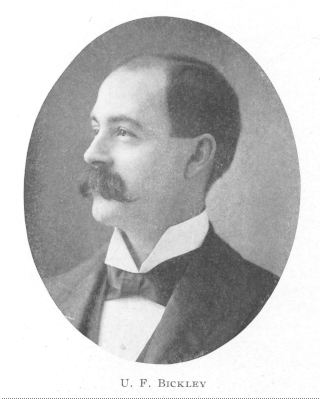
U. F. Bickley, The subject of this sketch was born on the 27th of March, 1866, in Morgan Township, Butler County, Ohio, being the eldest of four children, whose parents were Benjamin H. Bickley and Sarah Grant Bickley, each of whom were born and always lived in Butler County, Ohio.
U. F. Bickley, after completing the common school course attended the New London High School, where he finished, passing the county teachers' examination, obtaining a teacher's certificate, and began teaching school in Morgan Township, Butler County, Ohio, at the age of twenty years, and after teaching four years in the schools, accepted a traveling position, serving a year. He then resigned and entered the State University of Michigan at Ann Arbor, taking up the study of law and a special course in the literary department of the University. Graduating from that institution in June of 1893, obtaining his degree and standing second in his class of three hundred and twenty. Returning to Hamilton, Butler County, Ohio, he opened a law office in January of 1894 at Hamilton, Ohio, associating himself with Judge Philip G. Berry until April of 1895, when Philip G. Berry died; after which U. F. Bickley continued alone in the practice without the formation of any partnership or other association until July of 1902, when he took into partnership his brother, Ben. A. Bickley, who had previously completed a High School course in New London High School, and afterwards, having entered the State University of Michigan and graduating therefrom, and returning to Hamilton, formed the partnership of Bickley & Bickley, which now exists, and whose offices are in the new Rentschler Block, which firm follows the general practice of the law, having built a large and lucrative law practice, and ranking as one of the leading firms of Southern Ohio and of the Hamilton bar ; both members of said firm being strong and able trial lawyers before both Court and jury.
U. F. Bickley was nominated for Congress in the historical Third District of Ohio in June of 1900, and had as his opponent on the Republican ticket Hon. Robert M. Nevin, of
- 816 -
Dayton, Ohio ; which election, in November of 1900, was one of the most spirited and bitterly contested of any ever held in the Third Congressional District, at which U. F. Bickley was defeated by the small majority of one hundred and fifty-four votes. Since this time U. F. Bickley has taken only an active part in politics for his friends, although urged and requested to be a candidate for various offices. He has devoted his time and energies to the practice of law and other investments in which he is interested.
U. F. Bickley is a member of the Congregational Church at New London, Butler County, Ohio.; of Washington Lodge, No. 17, F. & A. M., and its higher bodies ; also is a member of the Knights of Pythias and of the Hamilton B. P. 0. E. Lodge of Elks, No. 93, being prominent in each order, and has a wide and extensive acquaintance in Butler County and throughout Ohio.
He is known and noted for his general knowledge and thorough scholarship, culture and refinement, and his social and genial nature, with his commanding presence, inspires a confidence in all those with whom he comes in contact, and proves him worthy of the high position and place he holds as a friend, counselor, lawyer and citizen.

Almon Mitchell Warner, A prominent attorney at law of Cincinnati, Ohio, was born on the 6th of March, 1843, at Plainfield, Hampshire County, Massachusetts. His parents, James and Fidelia Warner, were descendants of noted ancestors, among whom was Robert Bruce, once the idol of Scotland, Mr. A. M. Warner received a careful education both in the common and in private schools of Massachusetts, and in 1862 graduated with credit from Williston Academy, at the age of nineteen years. He then joined Company H of the famous Thirty-seventh Massachusetts Regiment. His position in his company was soon that of Second Sergeant, and upon being transferred to Company E he was promoted to the rank of First Sergeant. He took part in eighteen actual engagements, among them Gettysburg, Fredericksburg, Winchester and Petersburg. At the battle of Sailor's Creek, Virginia, on the 6th of April, 1865, he was severely wounded, while attempting to capture the enemy's flag, for which he was promoted for bravery from the ranks to the position of Lieutenant. On the 28th of August, 1865, he was honorably discharged. After regaining his health he studied law under Church & Sawyer, a noted legal firm of New York State, and was admitted to the bar in May, 1869, after which he immediately took up the practice of his chosen profession at Albion, New York. In the spring of 1870 he moved to Leesburg, Virginia, and later to Huntington, West Virginia, and in 1874 came to Cincinnati, where he has permanently settled, and in which city he enjoys an enviable reputation and practice. In political belief he is a staunch Republican. Mr. Warner is a member and Past Post Commander and Past Department Commander of Ohio of the G. A. R., a member of the
- 817 -
I. O. O. F. and F. & A. M. On the 12th of October, 1870, he married Elizabeth H. Densmore at Albion, New York. He is the father of two daughters by this union. His residence is located at No. 2643 Alms Place, and his office at the Lincoln Inn Court, Cincinnati, Ohio.
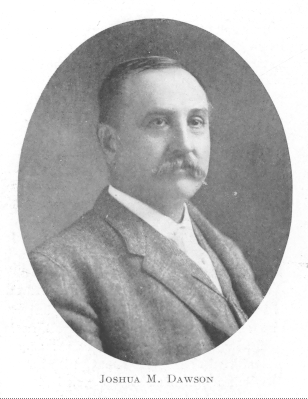
Joshua M. Dawson, Attorney at law at Cincinnati, was born at Columbus, Ohio. His father was the late Dr. John Dawson, an eminent physician of that city, a professor in the Starling Medical
College and editor of the Ohio Medical and Surgical Journal. His mother was Adelia Dawson, a daughter of Dr. Mathias Winans, one of the early pioneers of the State, and descended on his mother's side from the January family of Kentucky. Mr. Dawson's early youth was passed at the place of his birth, where he passed through the public schools and through the second year of the Columbus High School. At the age of eighteen he entered Washington College at Lexington, Virginia, then under the administration of General Robert E. Lee, as President. At the death of General Lee the college became enlarged to a University under the name of Washington and Lee. In his third year at this institution Mr. Dawson was honored with the President's Scholarship. Upon finishing the classical course at the University he commenced the study of law in the offices of Cox, Barnett & Follett, and enjoyed association with the three distinguished members of this firm—the Hon. Jacob D. Cox, Governor of Ohio, and Secretary of the Interior under General Grant ; Henry L. Barnett, now District Attorney of New York, and Hon. John F. Follett, ex-Member of Congress. In the year 1876 Mr. Dawson graduated from the Law School of Cincinnati, and was in the same year admitted to the bar. A few years later he became a member of the well-known law firm of Follett, Hyman & Dawson, and engaged in the general practice of his profession. In the year 1883 Mr. Dawson was elected City Solicitor of Cincinnati, and for two years directed the vast legal matters of that city. During his term of office the important litigation over the terminals of the Cincinnati Southern Railroad was successfully conducted and settled. Upon retiring from office, Mr. Dawson resumed the practice of law in connection with Mr. W. L. Overbeck, with offices in the well-known Hammond Building at Fourth and Vine Streets. Having a natural inclination for corporation law, Mr. Dawson was soon retained in important railroad litigation. In 1894 the controversy between the Monon Railroad and the Fort Wayne, Terre Haute & Southwestern Railroad, involving $750,000 of guaranteed bonds, arose, and Mr. Dawson was employed to represent the bondholders. He was afterwards elected President of the latter company, and continued in that office until the road became consolidated with the C., C., C. & St. L. Railroad. In 1895 the line projected by the late Colonel Jere Baxter, from Nashville to Knoxville, Tennessee, became
- 818 -
involvd in litigation and Mr. Dawson was retained in the interest of the contractors who built the road. The controversy involved large sums of money, and occasioned intricate legal proceedings in the Federal and State Courts of Tennessee, in all of which Mr. Dawson took part. In 1899 litigation arose over the Columbus, Lima & Milwaukee Railroad property, then just completed between Lima and Defiance, Ohio, and Mr. Dawson was employed by the original owners of the property to protect it against the attacks that were then directed against it. This litigation is still pending. During his busy career Mr. Dawson has been called upon to fill many places of trust and honor, among them being the trusteeship of the bondholders of the Kinnicinnick and Freestone Railroad, a branch of the Chesapeake & Ohio. In political matters Mr. Dawson has affiliated generally with the Democratic party, and has been tendered nominations for Prosecuting Attorney of his county and for Congress in the First District of Ohio. Both of these positions he declined, preferring the less exciting but more satisfactory life of his profession.
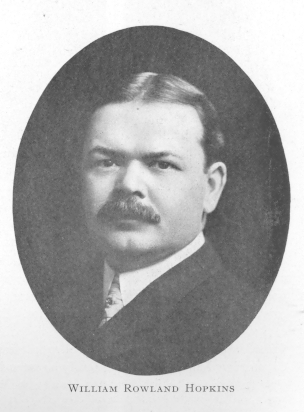
William Rowland Hopkins, Attorney at law. Born of Welsh parents at Johnstown, Pennsylvania, 1869, who removed to Alliance, Ohio, 1871, and to Cleveland in 1874. Attended Cleveland public schools, 1875-1881. Employed by Cleveland Rolling Mill Company in wire mill, 1881-1884, and in offices, 1884-1891. Graduated from Western Reserve Academy in 1892 ; from Adelbert College of Western Reserve University in 1896, and from Backus Law School of Western Reserve University in 1899. Admitted to Ohio bar in 1899. Author of "The Street Railway Problem in Cleveland," published by The American Economic Association. Member of Cleveland City Council, 1897-1899. Chairman Republican County Committee, 1902-1903. Married to Ellen Louise Cozad, 1903. Member of law firm of Hopkins, Bole, Cobb & Newcomb, Cleveland.
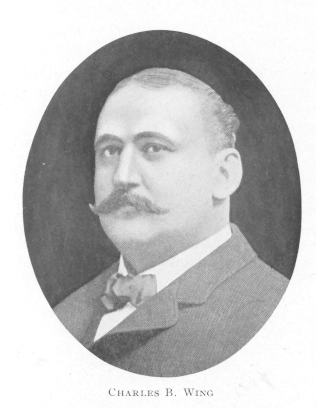
Charles B. Wing, A member of the firm of Diem & Wing, wholesale paper dealers in the city of Cincinnati, one of the largest enterprises in their line of business in this country, whose annual sales reach the total of more than $2,000,000, is a native of the Queen City, and was born on the 22d of April, 1854. He is of Welsh ancestry, his father, Thomas B. Wing, a wheel and hub manufacturers, having been born in Wales. Colonel Wing was educated in the schools of Cincinnati, and to-day stands a prominent figure in her industrial and commercial growth. In early years, Mr. Wing displayed a splendid talent for business, and step by step he advanced in commercial life, until he has reached his present position. Notwithstanding his large financial interests, which occupy a great amount of energy, Mr. Wing has found time to take an active interest in the political affairs of Cincinnati, and is
- 819 -
recognized as one of the leaders of the Republican party. He has occupied a number of positions of political honor with credit to himself and his party. On the 13th of January, 1896, he was appointed aide-de-camp to Governor Bushnell, and later he held the same honorary position under the late Governor Nash. In the spring of 1898 Governor Bushcinnell appointed Colonel Wing a member of the Cincinnati Board of Police Commissioners, and it is needless to say that he was one of the most efficient members of that important body. His record in that capacity stands unchallenged. He also served one term as a member of the Cincinnati Board of Education, and for four years he was a director of the Cincinnati Workhouse. Colonel Wing is a man of commanding appearance, broad in conceptions and determined in action. His word is unquestioned, and his career has been one of honor. As .a business man, he is conceded to be a splendid example of one who combines integrity with brilliant executive ability. He is a member of many social and commercial bodies, and is always ready to aid the industrial advancement and the general welfare of the city of Cincinnati. Colonel Wing is a member of the Blaine Club, an Elk and a Mason. He was married twenty-eight years ago, and is the father of two daughters.
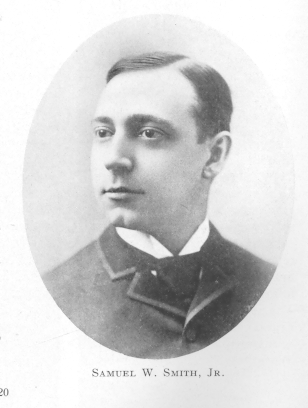
Samuel W. Smith, Jr., Judge of the Common Pleas Court of Hamilton County, is ranked among the leading exponents of the law in Cincinnati.. He was born in the Queen City, his father, Samuel W. Smith, being a wholesale liquor dealer. His early education was acquired in the public schools. In 1876 he was graduated from Chickering Institute. Subsequently he attended Brown University for four years and received his degrees. Upon his return to Cincinnati, he attended the Cincinnati Law School and was graduated in 1882, when he immediately becincame engaged' in his chosen profession, entering the law office of Lincoln & Stephens. After the decease of Mr. Timothy D. Lincoln, Mr. Smith was connected with the firm, which then became known as Lincoln, Stephens & Smith. He acquired an extensive practice, and in 1896 was elected Judge of the Common Pleas Court.
- 820 -
He performed his duties in so sterling a manner that he was re-elected to the same office by a greater majority in the November election of 1901.
John J. Cushing, A former representative attorney at law at Cincinnati, now at New York, was born on the 5th of October, 1854, in Sterling, Illinois. His father, Frank Cushing, was a well-known physician and farmer in Rhode Island, where he was born, while his mother was a native of New Hampshire. The ancestors of Mr. Cushing on the father's side came to. this country early in the seventeenth century, landing near the city of Boston, and settling in the town of Hingham, Massachusetts, which they named after that city in England. During the Revolutionary War and the War of 1812, members of Mr. Cushing's family participated in the great battles of those struggles. His mother's people were also of English descent, who came later to this country. They belonged to the famous Dow family in the East. Mr. Cushing was educated in the public schools of Sterling, Illinois, and 'in early youth was thrown upon his own resources, which necessitated him to work for a livelihood. He by his own labor earned sufficient to pay for his education in the Illinois State Industrial University, at Champaign, Illinois, where he took a mechanical engineering course, graduating in 1878. During this time he also studied law, and after careful preparation was admitted to the bar, in 1881, by the Supreme Court of Illinois. He later was admitted to practice in South Dakota, Colorado, Utah, Minnesota and the United States Courts. In taking up the profession of law he followed an old custom of the Cushing family, which has furnished many eminent members of the bench and bar of this country. One of the Cushings was Judge of the United States Supreme Court. Coming to Cincinnati, Mr. Cushing became actively engaged in his profession, and has been quite successful. In political belief he is a staunch Republican. He is a member of the Masonic fraternity and the Ancient Essenic Order. In the year of 1885 he was married to Miss Cordelia M. Senechal, of Illinois.

William King, Sergeant-at-Arms of the Senate of the Seventy-fifth and Seventy-sixth General Assemblies, was born on a farm in Pleasant Township, Madison County, Ohio, near McKendra Church, on the 1st of September, 1855. His great-grandfather on his father's side was born in Ireland, and his grandfather in Vermont, served in the War of 1812, and moved to Chillicothe, Ohio, in 1818. During his life-time Mr. William King has often been honored by the people, and on every occasion filled the positions with credit to himself and those he represented. Always an unflinching Republican, the record shows that he has held the following places : Township Assessor, Union Township, Marion County ; Justice of the Peace, Leesburg Township, Union County ; Assessor, Leesburg Township, Union County ; Mayor of Magnetic Springs, Union County, in
- 821 -
1890; Clerk of School Board, Magnetic Springs, since 1890; Postmaster at Magnetic Springs from 1888 to 1892 ; Mayor of Magnetic Springs in 1902 ; appointed Postmaster by President McKinley in 1897. Mr. King was born and raised on a farm and received all his education in the common schools of Madison County. He worked on the farm while at home, and for eight years after his marriage was engaged in agricultural pursuits. In 188o Mr. King lost his health, moving to Magnetic Springs six years later. He at once began to improve and now tips the beam at two hundred pounds. At the organization of the Senate in January, 1902, Mr. King was elected Sergeant-at-Arms and filled the onerous duties of that position to the satisfaction of everybody. On the adjournment of the Legislature he was presented with an elegant ring and other tokens of regard on the part of the Senate employees. Popular with all the Senators, Mr. King was highly regarded by those with whom he came in contact. At the organization of the present Senate, Mr. King was re-elected to the position he had filled with honor in the last Senate. Mr. King married Luticia Watrous on the 15th of September, 1878, at London, and two boys have been the result of the union: He has belonged to Lodge No. 664, Pharisburg, Independent Order of Odd Fellows, since 1889; Magnetic Springs Lodge, No. 380, Knights of Pythias, since 1890; Past Chancellor in K. of P. Lodge ; Master of Exchequer since 1894, and Representative fo the Grand Lodge from 1894 to 1896.
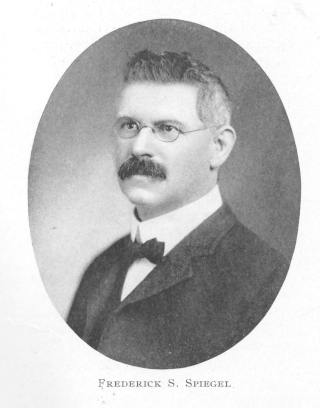
Frederick S. Spiegel, Judge of the Court of Common Pleas, First Ohio District, Cincinnati, Ohio, is a native of Germany, being born at Hovestadt, Westphalia, on the loth of November, 1856. He began his education at the Paderborn Gymnasium, and when he was eighteen years of age he emigrated with his parents to the United States, settling at Gadsen, Alabama. After his arrival in the New World, young Spiegel entered the Southern Institute, from which institution of learning he graduated in 1873. During vacation time of his last years aft this institution, he learned the printing trade at the "Gadsden Times," and also acted as reporter. Shortly after his graduation, Spiegel came to Cincinnati, where he accepted a position as proofreader with the old Franklin Type Foundry, joining at the same time Typographical Union No. 3, of which body he is
an honorary member. In 1876 he joined the editorial department of the Cincinnati Volksblatt, his leisure hours being devoted to the study of law under the preceptorship of Judge Clement Bates. Later he attended the Cincinnati Law School, graduated in 1880, and was admitted to the bar by the Supreme Court of Ohio. The year following he was appointed Chief of the Statistical Bureau of Ohio. While thus in Columbus, he was elected a member of the Cincinnati Board of Education. Returning to Cincinnati, Judge Spiegel associated himself with Judge A. H. Bode, which firm soon became one of the most foremost in the
- 822 -
legal profession of Hamilton County. in 12389, Judge Spiegel was elected to the City Council, and in 1890 and 1893 to the position of County Solicitor, serving two terms with great distinction. In 1896 he was elected to the Common Pleas Bench, and re-elected in 1901. Judge Spiegel is married, and lives on Walnut Hills, Cincinnati. He is a thirty-second-degree member of the Masonic fraternity and of numerous literary and social clubs.
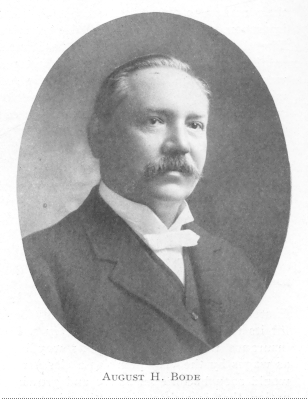
August H. Bode, A representative member of the Hamilton County Bar, was born on the 3d of July, 1845, in Peine, near Hanover, Germany. He obtained a very careful education in the schools of his home city, at Auhagen's Institute, at Hanover and at the celebrated Polytechnikum of the latter city, graduating from the same after a four years' course in mathematics and engineering. He then matriculated at the Berlin University, but after one year's study accepted a position in the engineers' department of a machine factory. He later filled a position as engineer on a transatlantic steamer, and after crossing the ocean a dozen times, finally, in 1867, remained in the New World and settled in Cincinnati. In this city he filled the positions of teacher and Principal for the next fifteen years, resigning in 1883 to take up the practice of law, for which he had prepared himself after long and diligent studies. He formed a partnership with Judge F. S. Spiegel, which 'soon became one of the most prominent law firms of Cincinnati. After the elevation of Mr. Spiegel to the bench of the Common Pleas Court, Mr. Bode has practiced under his own name. He is a lawyer of more than ordinary abilities, high character and well-merited reputation for calm judgment and unselfish devotion to the public good. He has always taken a keen interest in all matters pertaining to the welfare of his fellow citizens; and his countrymen in particular. For many years he was Financial Secretary of the German Evangelical St. Paul's Church ; Secretary of the German Protestant Orphans' Association ; First Speaker of the West Cincinnati Turnverein, and since 1899 he occupies the position of President of the German Day Association of Cincinnati, a combination of all the, principal German societies of Cincinnati. He also is a Mason of high standing. In political belief Mr. Bode is a staunch Republican, who has rendered the party of his choice many valuable services, in the councils as well as on the stump during political campaigns. His arguments as a political speaker are plain, direct and convincing. For a number of years Mr. Bode was a member of the Board of Education, of the Board of Teachers' Examiners, and is now one of the most valuable members of the Cincinnati Union Board of High Schools. He was also a member of the Cincinnati Board of Elections, and for some time occupied the bench of the Cincinnati Police Court. In 1872 he was united in marriage to Miss Augusta Pruess. Three daughters and two bons are the issue of their union, one son,
- 823 -
August H. Bode, Jr., one of the most promising younger members of the Hamilton County Bar, being connected with his father in the practice of law. Mr. Bode's office is located in the Atlas Bank Building, Cincinnati, Ohio.
The Western and Southern Life Insurance Company. It was a firm conviction that it is unnecessary for people in the Central States to send their money to the Atlantic coast as life insurance premiums, to borrow it back later for improvements necessary in the development of their section, that called into corporate being The Western and Southern Life Insurance Company of Cincinnati.
This company was organized, chartered and commenced doing business in 1888, and was the first life company west of the Alleghenies to undertake the writing of industrial insurance. It is perhaps unnecessary to explain that industrial insurance differs from ordinary life insurance only in the size of the policies and the method of paying premiums. Ordinary insurance is usually issued for some multiple of $1,000, and annual premium rates vary according to the age of the person insured at the time of taking the policy. Industrial insurance is based upon the same tables of mortality, but policies are issued for irregular sums, varying from $5oo down to $10. The rate of premium is some multiple of five cents, and is payable weekly—collectors calling at regular intervals at the homes of the persons insured. Instead of the premium increasing for older ages, the amount of insurance that five cents a week will buy gradually decreases as the age at entrance of the person insured increases.
Dr. Frank Caldwell, then a practicing physician and surgeon in Cincinnati, was the founder of the company, its first President, and remains in that position at the present day. His idea was that industrial risks could as well be carried by Ohio Valley capital as by Eastern corporations ; that a company organized in this section could find a ready market for its real estate loans ; that money paid by artisans and by laborers for their protective insurance would quickly find its way back into channels where it could be earned back as wages by the very men (as a class) who had paid it in ; that an industrial life company would soon become an active and growing factor in the development of the section of the nation that is richest, from the view-point of natural advantages.
The promoter of this idea found Tittle difficulty in enlisting capital for the enterprise, a number of prominent and substantial Cincinnati business and professional men entering the directory of the company. Articles of incorporation were applied for, and a deposit of $100,000.00 as a guarantee fund was made in the State treasury.
Dr. Caldwell was elected President of the company, as has been stated, and William J. Williams, who for a number of years previous had looked after the details of a large Masonic insurance body, was chosen Secretary. Practically all of the work of the company's home office—then a suite of two rooms in a Main Street business block—was performed by these two officials, and they remain the most active factors in the company to-day—gradually, of course, as the volume of work compels, giving over details to subordinates, but continuing as at the outset, to keep the closest possible touch of the company's affairs, and personally looking after the interests of policy holders.
The company commenced operations in the city of its nativity, nor did it seek to widen its field until a firm foundation had been established. Then commenced the process of development and expansion which to-day covers the entire area drained by the Ohio River and the Lake Erie basin.
Original quarters soon became inadequate and a home office was established on West Sixth Street. This in 1901 gave way to the company's present home at Fourth and Broad-
- 824 -
way—a spacious building owned by the company and occupying a site which will admit of future expansions as additional floor space shall be required.
The early years were, of course, a struggle. The little Western pioneer was at first laughed at by the older competitive corporations in the East, and its early policy holders were disturbed by agents of other companies. However, in spite of attempts to hinder and prophecies of an early retirement from the field, the little company closed the year 1888 with $889,073 of insurance in force on 6;237 lives.
Since then the company has pursued a steady and conservative growth, and to-day it has over $28,000,000 of insurance on more than a quarter million of lives. On January 1st, 1904, its statement shows outstanding insurance aggregating $25,715,285 on 213,205 lives.
To serve well the interests of its policy holders has ever been the broad principle upon which the Western and Southern Life has conducted its operations, and it is easily to-day the most democratic institution of its kind in America. Its organization in office and field is built along lines of usefulness only. It promulgates no array of high-sounding titles attached to meaningless names, but limits its forces to the number actually required to carry along the work with accuracy and despatch.
The prompt payment of claims has been practiced for so many years that it has become a fixed habit, and unnecessary delay in this vital branch of the business is never tolerated. It is held by the company that when death invades a home, there follows instantly a need for ready cash. This need it undertakes to meet when the death is in the home of a policy holder. It has distributed over a million and a half of dollars as death claims in its corporate history, and practically all of this money has been paid out within an hour or two from the moment the proofs of death were received at the home office. It is no uncommon matter for a sorrowing wife or mother to receive her check from the Western and Southern Life before her child or husband has been laid in its last resting place.
Solicitous care for the policy holders extends, of course, beyond the detail of paying just claims. Daily collections are adding to the fund which is held in trust for future demands of the living members as they shall be claimed by death. The extreme of care and conservatism is maintained in the handling of this fund. The company invests in no stocks and bonds at any time, or under any circumstance. Loans are made on first mortgage real estate security only after careful investigation as to values offered. Any surplus is invested in United States bonds. On January 1st, 1904, the company had assets of $1,074,653. Of this sum over $050,000 was held as a reserve fund to protect the future claims of policy holders.
While it is commendable—this exercise of conservatism and care in the management of a fiduciary trust such as a life insurance company—a part of the credit must go to the law makers of the State of Ohio, who have framed and delegated to the Superintendent of Insurance for enforcement perhaps the most rigid code of insurance statutes in the nation. Officials of the State make a rigid examination of the company's books and papers each year—something that is not done in any other State.
From 1888 until 1902 The Western and Southern Life confined itself to the writing of industrial insurance only. As years went on and the company's volume of business increased, its force of agents in the field became larger and stronger. The plan of industrial insurance contemplates the issuance of policies on lives from 2 years of age to 70.
By 1902 the men in the field found that many persons who had been insured as children had grown to mature estate, and were anxious to carry additional protection in the company with which they were so familiar. To meet this demand, as well as to widen its sphere of activity and usefulness, the company undertook the writing of ordinary insurance
- 825 -
issuing policies for from $1,000 to $5,000 on whole life, limited payment life, or endowment plans. The success which followed the company's initial efforts at writing industrial insurance have been duplicated in its experience in the ordinary life field.
And so, to-day, the people of Ohio may well be proud of the fact that their State granted a charter to The Western and Southern Life, and may be well pleased to number it among their institutions. Commencing in a modest way, it remains to-day a modest company—never undertaking to make strides beyond its strength, and holding to the truism that "corporate integrity, absolute safety, low cost and satisfactory results in life insurance are in no way dependent upon the size of the company issuing the policies, nor to its 'recent rapid growth.' " A modest company, as has been said, The Western and Southern Life points rather to its past record than to its future prospects, and invites the testimony of those it has served rather than the prophesies of those who look ahead. Sixteen years of uninterrupted upbuilding indicate, of course, the staunchness of the company ; and operating over a wider area and through a larger field force, it is but natural that future development will be more marked than the past. It requires no elaborate arithmetical calculation nor stretch of sensitized imagination to find that future date when The Western and Southern Life will be among the first financial concerns of that section which Eastern people are fond of calling "the Middle West." Each year finds it a more potent factor in the development of that territory which it calls "home." Its capital has improved countless business sites, and through loans on their realty has helped industries into being. It has, in a measure, given the artisans and laborers more than the protection of insurance : it has helped to sustain that general proscinperity which makes for the good of all concerned.
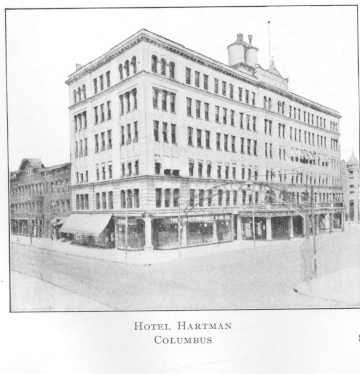
Hotel Hartman, Located at Main and. Fourth Streets in the city of Columbus, Ohio. In this age of advance and progress there is no feature more marked than the modern hotel. Columbus
is noted for excellence in this line, and each new addition shows advanced ideas. On the 16th of November, 1902, the new Hartman opened its doors to the public with attractions surpassing all that has gone before. It has one hundred and twenty rooms with the latest appointments in modern architecture and sanitary plumbing, all being the work of local artists. The office lobby, bar, dining room and halls leading to same are floored with tiling, the rooms are finished
in hardwood, including floors (parquetry), with private lavatory and toilet finished in tiling, ventilated by an exhaust fan ; the furniture is of solid mahogany in Colonial design, solid brass beds, private telephone, electric lights and thorough ventilation. Each hallway has a cozy reception corner with easy chairs and tables for games or reading. The approach to the dining hall
- 826 -
is through a corridor with broken outline draped with Oriental portieres and offset with palms. The dining hall is gorgeous in the display of Liby cut glass and Reed and Barton's designs in silver. The walls are mahogany paneled with plate glass mirrors and windows, the ceiling and frieze of special designs in oil painting with green and old ivory in bass relief. The four hundred and fifty-seven electric lights are so arranged that the softer lights are thrown on the paintings with stronger reflections on the tables and general outline. Glancing from the soft tinted ceiling to the tables with their glitter of silver and cut-glass, mahogany furniture, soft lace curtains and graceful tropical plants, the effect is one of harmony and contrast which is rare, and marks the designer as an artist of high degree. The service is exclusively European. A tour through the kitchen shows an arrangement that is unique and convenient, solid glass ice chests and steam heated ovens, tiling floors and a spotless cleanliness in every nook which is characteristic of the entire premises. The table ware is the product of the Oneida Pottery Company, of Syracuse, New York, designed especially for the Hartman. Private dining rooms for small parties are furnished in harmony with the main hall, the entire house being in Oriental effect complemented by evergreens in various shades in most engaging color effect. The bar is furnished with Liby cut-glass and plate glass mirrors, the furnishings of the room in leather upholstery. The most distinctive oriental feature is a porch ninety by eighteen feet extending over the Fourth Street entrance, floored with ornamental tiling and furnished with rockers and footrests, with pot flowers and palms in the midst. This is indeed a haven of rest to the tired commercial traveler and a delightful resort to the pleasure-seeking tourist. The entire building is steam heated, and from office to garret lacks no feature of completeness. The manager, M.. John G. Dun, is a native of Columbus, and eminently fitted for the place he fills. The increase in patronage, which has been phenomenal from the first, is due to his thorough knowledge of affairs and personal attention to every detail. The comfort and pleasure of every guest is anticipated and impartial courtesy shown to all. This is one of the handsomest and most modern hotels in the State. Columbus is to be congratulated on having such an enterprising promoter as Dr. Hartman in its limits.
The O. Armleder Company. Cincinnati enjoys the distinction of being the largest carriage and wagon market in the world. Among the largest enterprises in this industry, and one which has pushed itself to the front in the last decade is the O. Armleder Company, the largest manufacturers in the world of business delivery wagons. Under the most capable management this company has made the most wonderful progress since its organization, less than fifteen years ago, and it now occupies the first place in the world among its competitors. The progress was so rapid that new buildings which were added to their original plant soon proved to be much too small, until lately the immense building on Plum, Twelfth and Charles Streets, Cincinnati, Ohio, was purchased for their purposes. This covers an area 200 by 200 feet and the floor space is 168,478 feet. The Twelfth Street building is six stories and those in Plum and Charles Streets rise five stories. These buildings are so arranged that every foot of space is supplied with natural light. The most remarkable feature of this plant is the elimination of shafting and belting. Every machine has direct connection with an electric motor, so that any one machine can be stopped without interfering with the balance of the machinery. All this equipment exhibits the most modern type of development and necessarily reduces the cost of manufacture to a minimum. The buildings are heated by a new vacuum heating system and have been painted throughout with fire-proof paint and every other precaution taken to prevent a conflagration. A large cellar has been constructed
- 827 -
outside the buildings for storing thousands of gallons of oils and paints. Nothing has been left undone from a sanitary standpoint in the way of up-to-date plumbing and toilet rooms and showers for employees.
This company is one which Cincinnatians are proud of, because it is the epitome of that aggressiveness and enterprise that characterize so many of our successful industries, and it has risen from a small wagon shop to the largest exclusive builders of fine delivery and
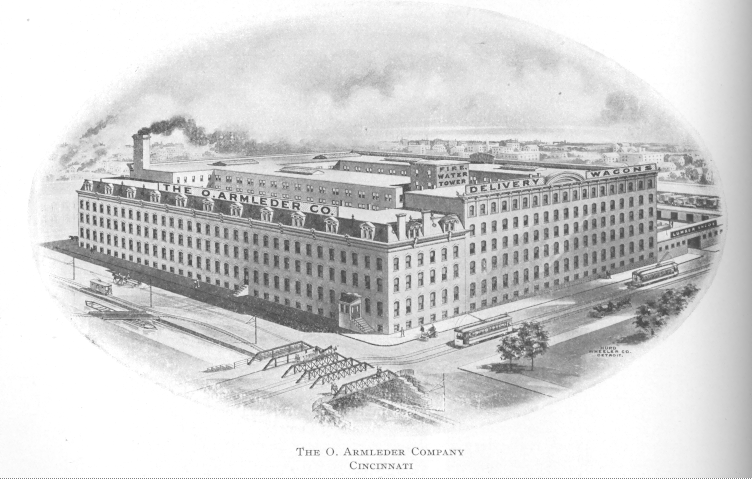
THE O. ARMLEDER COMPANY
CINCINNATI
undertakers' wagons in the world. Their work is shipped into every State in the Union and their foreign shipments amount to many thousands of dollars annually. The constantly increasing demands for their wagons compelled them to build this fine new plant, where they will have a capacity five times as great as in their fosrmer quarters.
Mr. Otto Armleder, the moving spirit in the concern, is the popular President of the Fall Festival Association, and one of Cincinnati's most respected citizens.
The Cincinnati Sanitarium, Located at College Hill, the highest elevation in Hamilton County, is one of the most worthy institutions of the Queen City. It is a private hospital for the care and treatment of persons of unsound mind, and has provisions for the most serious grades of neurasthenia and hysteria, nervous prostration, etc. It also treats patients suffering from alcoholic
- 828 -
excesses, as well as those addicted to the use of opium and other drugs. The institution is an incorporated organization, owned by stockholders, governed by a Board of Directors, and has at its head a medical director of National reputation, and one who is not interested as a proprietor. The institution was founded in 1873, and since that time has treated more than 4,000 patients, nearly 45 per cent of whom left the institution permanently cured. This is a very remarkable record, inasmuch as the percentage of cures in similar institutions in this country is but 33 1-3 per cent. The most conspicuous features of the sanitarium are perfect salubrity of location, combining the seclusion of the country with easy access to and from the city ; exceptional facilities afforded by numerous buildings for individual treatment of a variety of invalids ; the absence of all quackish or meretricious pretensions or practices; the reputation acquired by successful treatment of insane and otherwise impaired persons ; the absence of all influences engendered by monetary influences, and the exceptional reputation of the medical staff retained by the Board of Directors. The Cincinnati Sani-
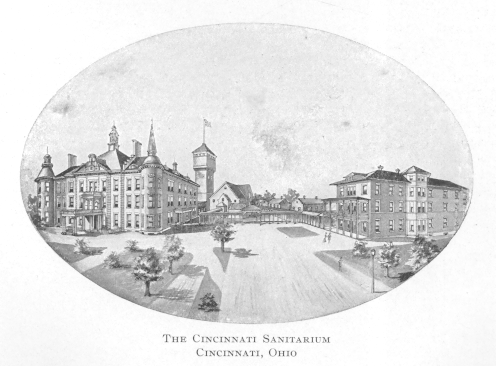
THE CINCINNATI SANITARIUM
CINCINNATI, OHIO
tarium is a beneficent, but not a benevolent institution in the accepted meaning of the word. It has done and can not avoid doing in the ordinary course of business much gratuitous, if not charitable work ; but the purpose of its directors has been and is to furnish accommodations and the best possible treatment for a class of persons financially able to pay for treatment, whose conditions require seclusion from public view and excitations, or those who desire to be spared a notoriety or history of legal commitment to and residence in State institutions, thereby becoming dependent wards of the people. The aim of the institution is not one by which it is expected to accrue large rewards for services, but rather to receive sufficient pay to cover the actual cost of administration and make such improvements and enlargements as become necessary from time to time. The grounds of the institution cover twenty acres of diversified park, well supplied with magnificent forest trees and an unfailing spring of excellent water. The commodious and convenient buildings have been constructed expressly for hospital purposes. As accessories to the welfare
- 829 -
of patients, the amusement pavilion, billiard room, conservatory, and the proximity of a select suburban community, with its society, churches, schools, etc., are all to be taken into consideration. Dramatic and social entertainments are given at frequent intervals under the thoughtful direction of the President and manager, with every evidence of benefit to those concerned. The Board of Directors is headed by Mr. John C. Sheets, President and Business Manager, a most able man, particularly adapted for the successful guidance of the great institution.
Moch, Berman & Co., Of Cincinnati, manufacturers of the celebrated "Wellworth" Dressing Clothing, have done much to spread the fame of Cincinnati all over the United States. The clothing manufactured by this firm is appreciated by the best dressed people of the country, and the

MOCH, BERMAN & COMPANY
CINCINNATI, O.
trade name "Wellworth" is a guarantee of perfect taste, splendid workmanship and first-class material, while the name of Moch, Berman & Co. stands for everything that is clean in labor. The goods emanating from this immense establishment are the product of the most skilled
- 830 -
artisans in the clothing business, every one of whom is a member of the United Garment Workers of America, the National body of union labor for the manufacture of clothing. The present members of the firm, M. E. Moch, Samuel Berman, Albert Moch and Charles S. Moch, were the original organizers of the firm, which was established in the year of 1880. They were all young men at that time, and careful training and experience in the art of manufacturing clothing, as well as being capable salesmen, previously having been employed in an old and well established firm, since retired. From its beginning the firm has met with wonderful success, and year by year has grown and flourished. The immense patronage obtained by Moch, Berman & Co. compelled them in 1901 to erect the magnificent building in which they are at present located. This structure is one of the sights of the factory district of Cincinnati, and is the largest plant in the United States devoted to the manufacture of union-made clothing. It contains 140,000 square feet of utilized space, and has a frontage of 84 feet with a depth of 200 feet. It is seven stories high, excluding the basement. Every facility for the economical and proper operation of the manufacturing department is included and no where in this or any other country can be found better arrangements in this direction. On the first floor can be seen the counting room, sample room, purchasing room, as well as private offices for all the members of the firm. As an evidence of the careful consideration given to the employees of the concern, it should be stated that a library has been installed on the first floor, as well as toilet rooms for ladies and gentlemen, the same being finished in Italian marble and furnished with shower and tub bath rooms. A marble drinking fountain dispenses filtered ice water, and the buffet is always well stocked with fragrant Havanas and liquid refreshments for visitors and friends. A cordial invitation is extended to all visitors to Cincinnati, to call and inspect the new business home, which 's situated on the corner of Elm and McFarland Streets, Cincinnati, Ohio.
Bullock Electric Manufacturing Company, In this great era of progress there can be no doubt that the great commercial development owes its unparalleled strides directly to the electrical industry. The Bullock Electric Manufacturing Company takes great pride in feeling that it has contributed something toward this progress. The electrical machinery manufactured by the Bullock Company has received widespread attention both in this country and abroad. Bullock apparatus has been installed in every State in the Union.
The George F. Card Company, which began business in 1886, was the nucleus of the Bullock Company. The product at that time consisted of a patented time current meter and a small line of motors ranging up to fifteen horse-power capacity. The factory was located on the lower floor of the building situated at Second and Plum Streets, and had about twenty-five men on the pay-roll. In addition to the manufacture of motors above mentioned, a general repair business was carried on, and one of the company's best customers was the South Covington Railway, the President of which at that time was Mr. George Bullock. About this time the Card Company required financial assistance, and Mr. Bullock became interested in it. In 1891 the style of the firm was changed to the Card Electric Motor and Dynamo Company. The quarters at Second and Plum Streets having been outgrown, a large four-story building was erected at Hunt and Broadway, the entire building being used for the manufacture of electrical apparatus. In 1896 Mr. Bullock, practically owning the company, and also being President of it, decided to change the name to the Bullock Electric Manufacturing Company. The company was an Ohio corporation, with an authorized capital stock of $1,000,000. The number of employees had now increased to sixty, and machines were built up to 200 k. w. in size. The business was increasing
- 831 -
in giant strides, and early in 1897 the new building was found to be entirely inadequate. The local trade was extended and offices opened in the large cities. The volume of business which flowed in through these new channels exceeded the most sanguine expectations of the company. It became necessary to increase the capital stock to $2,00o,000, and the company was re-incorporated under the laws of the State of New Jersey. At the same time a tract of land thirteen acres in extent was acquired in East Norwood, a suburb of Cincinnati, located at the junction of the B. & 0. S. W. Railroad and the Pennsylvania Railroad. Plans were prepared and work begun at once on a factory comprising the most modern design. The plant included an office building i00 feet square and two stories high, a machine shop 300 feet long and 101 feet wide, and a power house 177 feet by 60 feet. The buildings are of buff-colored pressed brick, with structural steel frames, and were occupied in December, 1898, with one hundred and fifty employees on the pay-roll. The buildings were designed for a ten year growth, but by the end of December, 1900, the number of employees had been increased to four hundred and the size of the machines ranged up to the 800 k. w. unit. The capacity of the shop now being taxed to its limit, an addition of 200 feet was made early in 1901, and was filled as soon as completed. An additional building was also erected for the pattern shop and brass foundry, 100 feet by 60 feet. The
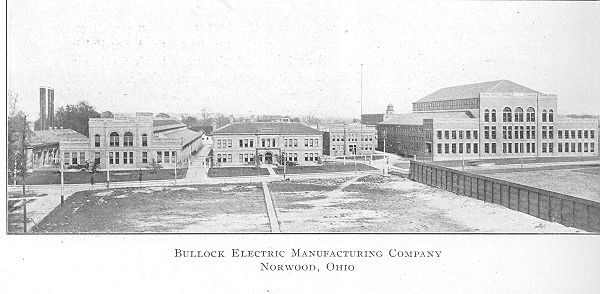
BULLOCK ELECTRIC MANUFACTURING COMPANY
NORWOOD, OHIO
volume of business was steadily increasing, and the fall of 19o1 found further extensions necessary. These were prepared, and consisted of a service building 55 feet by 26o feet long, two stories high, and a machine shop, No. 3, 177 feet by 1,200 feet long, 300 feet of which, together with the service building, was erected at once.
The company has recently acquired the Bollman & Wilson foundry, situated directly opposite the factory. It consists of seven acres of land, and is the most modern foundry in Cincinnati. This plant supplies all the company's iron castings, and has a capacity of seventy-five tons per day. Further extensions are now in progress, which include the rebuilding and extending of shop No. 2, which will be 101 by 300 feet long and two stories high. A four-story building, 55 by 20 feet, is also being erected near the foundry for the making and storing of patterns. A night force has been employed since October, 1900, in order to catch up with orders. The force at present consists of nearly 1,250 men, while
- 832 -
the size of the machines is 'practically unlimited. Machines are at present being built in units of 8,000 horse-power capacity, and the company is equipped to build units of 10,000 k. w. This company has built the largest sixty-cycle alternator and the largest direct-current generator in the world. Both these machines have recently been installed in the new power house of the Cincinnati Gas and Electric Company. The alternator furnishes current for all the arc lamps in the city.
On the 1st of March, 1904, this company entered into an alliance with the Allis-Chalmers Company. By this combination the interests of both companies are under one management. The joint companies are the largest manufacturers of power machinery in the world, furnishing complete equipments for steam, gas, water and electric plants.
The Champion Coated Paper Company. As the paper in this publication is printed on coated book paper made by The Champion Coated Paper Company, Hamilton, Ohio, it is proper that something be said about this company in this volume.
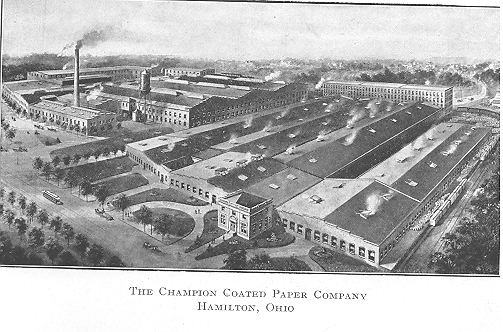
THE CHAMPION COATED PAPER COMPANY
HAMILTON, OHIO
There are twenty-one paper coating mills in the United States, of which The Champion Company is the largest, having a capacity of all the other mills combined. Its daily product is upwards of 250,000 pounds of coated paper. It handles in and out about twenty-five carloads of material and finished product daily. The entire plant is operated twenty-four hours daily, except on Sundays. The coating or surfacing material is made from a peculiar white clay that is only found in England, and that has been freed from all foreign matter by repeated washing. This clay resembles in its dry state a fine, white chalk, except that it has a softer and more saponaceous appearance. To make it adhere to and practically become a part of the paper, a fine grade of glue is mixed with the clay. After the paper is coated, it is then compressed and polished between rollers on enormous calenders, which gives it the proper finish. About 70,000 pounds of China Clay are consumed daily
- 833 -
in this mill and about 15,000 pounds of glue. The product of this company is shipped to all parts of the world and nearly all of the large magazines in the country are printed on their paper.
Mr. Peter G. Thomson, the President and guiding spirit of this company, is assisted in the management by his two sons, Peter G., Jr., and Alexander, both capable young men, who began at the bottom and arrived at the top, with every qualification for carrying on the enterprise their father had created and developed. The Secretary and Treasurer of the company is S. M. Goodman, also well known in Cincinnati.
Mr. Peter G. Thomson was born in Cincinnati on the 16th of December, 1851. He was educated in the public schools, and started into business for himself early in life. For many years he was with Robert Clark & Co., the Cincinnati book dealers. At the age of twenty-three, he opened a book and stationery store for himself at the corner of Vine and the Arcade, in the Emery Hotel Building. Later on he sold out this business and embarked in the publication of children's toy books and games, which was afterwards sold to the firm of McLaughlin Bros., in New York.
In 1892 Mr. Thomson bought the 187-acre tract in Hamilton known as the Prospect Hill and Grand View Addition. It was to develop the property that he conceived the idea of building the Black Street Bridge, and to further develop the property that he started the business of The Champion Coated Paper Company, which has developed to its present enormous business. The large paper mill connected with the coating plant is the largest book paper mill in the world, having a capacity of fine book paper amounting to one hundred tons daily. A visit to these two plants is one of the sights seldom seen and never forgotten.
- 534 -
EXPLANATORY NOTES
INSCRIPTION ROCK, KELLEY'S ISLAND, LAKE ERIE
The Inscription Rock lies on the south shore of Kelley's Island in Lake Erie, about sixty rods east of the steamboat landing. The rock is 32 feet greatest length, 21 feet greatest breadth, and 11 feet high above the water in which it sets. It is a part of the same stratification as the island, from which it has been separated by lake action. The top presents a smooth and polished surface like all the limestone of this section of the country when the soil is removed, suggesting the idea of glacial action ; upon this the inscriptions are cut; the figures and devices are deeply sunk in the rock. Schoolcraft's " Indian Antiquities" says of it : " It is by far the most extensive and well-sculptured and best-preserved inscription of the antiquarian period ever found in America." It is in the pictographic character of the natives; its leading symbols are readily interpreted. The human figure, the pipe, smoking groups, and other figures denote tribes, negotiations, crimes and turmoils, which tell a story of thrilling interest, connected with the occupation of this section by the Eries ; of the coming of the Wyandots ; of the final triumph of the Iroquois ; and the flight of the people who have left their name on the Lake. (See page II.)
CINCINNATI IN 1802
At the beginning of the last century the present "Queen City of the West" was a little hamlet. The principal structure was "Fort Washington", erected as a protection against the attacks of hostile Indians. The other prominent buildings were the following : 1. Residence of Major Wm. Ruffin; 2. Artificers Yard; 3. Residence of Charles Vattier ; 4. Residence of James Smith ; 5. Residence of David Ziegler (first Mayor of Cincinnati); 6. Residence of Griffin Yeatman; 7. Residence of Martin Baum; 8. Residence of Col. Gibson; 9. Residence of Joel Williams; 10. Residence of Israel Ludlow; 11. Green Tree Hotel; 12. Residence of Samuel Best; 13. Presbyterian Church; 15. Residence of Dr. Allison. 14 is Fort Washington. (See page 39.)
TURKEY FOOT ROCK
The battle of " Fallen Timbers" was fought on the 20th of August, 1794. Two thousand Indians and Canadian Volunteers attacked the advance of the army of General Anthony Wayne from behind trees prostrated by a tornado. The American troops pressed forward with great energy and drove the enemy toward the guns of Fort Miami and the water of the Maumee Bay. The victory was complete. There is a tradition that Turkey Foot, an Ottawa chief, fell at the foot of Presque Isle Hill while endeavoring to rally the retreating warriors. He was pierced by a musket ball while standing on a large rock and encouraging his men. His tribe entertained so much affection for him that long years afterward when any of the tribe passed along the Maumee trail they would stop at the rock and linger for a time with great manifestations of sorrow. The stone is still there within a few steps of the gentle-flowing Maumee, with many rude figures of a turkey foot carved on it as a memorial of the English name of the lamented Me-sa-sa, or Turkey Foot. (See page 53.)
TOWBOAT "SPRAGUE"
The Ohio River enjoys the distinction of possessing the largest and most powerful craft on inland waters in the world. This craft is the towboat "Sprague", estimated to handle in safety not less than 1,750,000 bushels of coal. The boat is 275 feet long and has a beam of 65 feet. Its machines have 16,000 horsepower. (See page 85.)
- 835 -